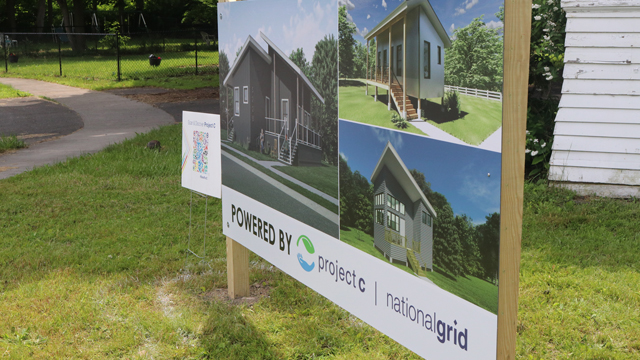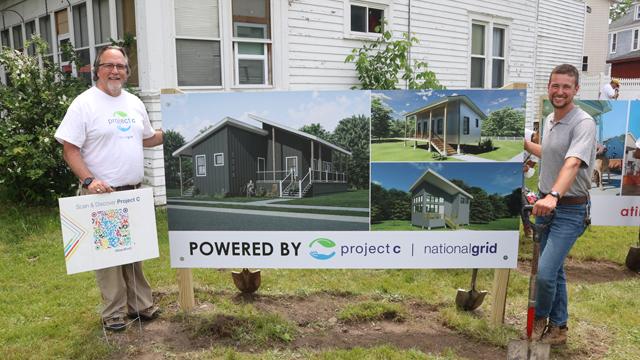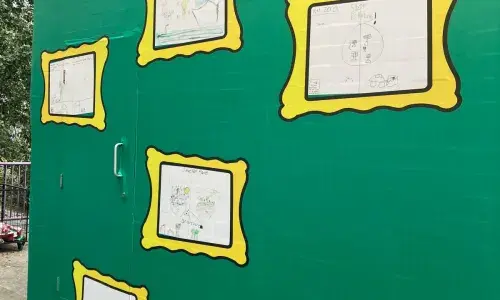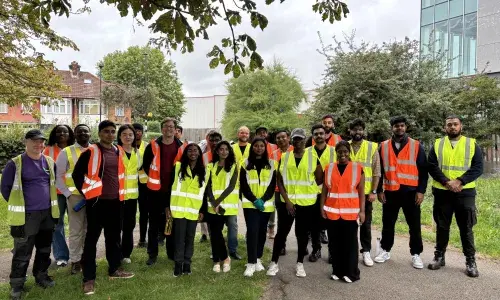
Solar-powered tiny homes help tackle homelessness in New York
National Grid has teamed up with A Tiny Home for Good to help those who face homelessness in Central New York State, providing them with places to live and thrive that are also affordable and energy efficient.
These ‘tiny homes’ are much smaller than average sized houses, which means they naturally require less energy, lighting, heating and cooling, and as a result their energy bills are significantly lower.
In early 2022, we partnered with A Tiny Home for Good to build four tiny homes powered by solar energy in the Southwest neighborhood of Syracuse, NY. The homes are being built over the course of 12-18 months, before they are rented at an affordable rate to individuals in need.
A Tiny Home for Good will build and manage the homes, while National Grid will provide funding for construction. Architect Brad Wales engaged his senior design-build class at the University of Buffalo to design each home, which will be built on neighboring vacant lots on Rich Street.
Why power the tiny homes with solar energy?
1. Solar power can provide almost all the energy the homes will need
It’s anticipated that the solar panels installed on the tiny homes will provide all the power for the homes, except for heating. Heating can be provided by electric heaters or heat pumps – another clean alternative. If the solar panels produce more energy than expected, this will help to heat the homes as well.
Even when the sun isn’t shining directly on them, solar panels still function, as they use direct and indirect sunlight to generate power. Because of this, clouds don’t negatively affect solar panels – in fact, rain can actually help solar panels, as it cleans off any dirt or residue.
2. It avoids greenhouse gas emissions
While these tiny homes are actively combating homelessness in Syracuse, they’re also contributing to a greener city. The tiny homes are powered by solar energy; a renewable and infinite energy source that creates no harmful greenhouse gas emissions. As long as the sun continues to shine, energy will be released.
3. Solar power is a cost-effective option
Because tiny homes are significantly smaller than average-sized homes, they require much less energy, so solar power is a cost-efficient option. The solar energy needed to power a tiny home costs one-tenth of the price compared to an average sized home.1
4. Making the most of available natural resources
The homes have a lot of south-facing light, so solar panels make the most sense compared with options like geothermal energy, which would be more expensive to implement without providing enough benefit.
Who will live in the tiny homes?
A Tiny Home for Good launched in 2016, with the mission to provide safe, affordable and dignified housing for those coming out of the shelter system. Since then, 25 individuals have been housed and are making new lives for themselves, one step at a time.
The tenants of these unique tiny homes are strong, hardworking and have overcome many challenges. Some of the tiny home tenants are:
-
Dolphus, who became A Tiny Home for Good’s first tenant six years ago and since then has become an integrated member of the community
-
Jeanette, who struggled with opioid addiction and lost her home, but since moving into her tiny home has created relationships and works at a local veterinary clinic
-
Steve, who is a friendly neighbor who takes care of his property and always has a positive attitude, despite suffering from a stroke.

Why is National Grid supporting these tiny homes?
This partnership forms part of our Project C initiative, which focuses on supporting the people and communities we serve across New York.
Without realizing it, average homeowners emit a large quantity of greenhouse gases. In 2020, homes and businesses accounted for 13% of total U.S. greenhouse gas emissions.2 Tiny homes are a cleaner way of living, actively combating greenhouse gas emissions as well as offering lower costs for homeowners.
National Grid, through our Project C initiative, is proud to support A Tiny Home for Good and its innovative approach to getting people off the streets and into homes that are safe and affordable.
“Just as no one should go hungry, no one should be without a roof over their head,” says Alberto Bianchetti, regional director of customer and community engagement. “National Grid, through our Project C initiative, is proud to support A Tiny Home for Good and its innovative approach to getting people off the streets and into homes that are safe and affordable.”
A Tiny Home for Good can combat the growing rate of those who face homelessness with the help of their staff and partnerships.3 “Partnerships like this are how we end homelessness in Syracuse,” said Andrew Lunetta, founder and executive director for A Tiny Home for Good. “We’re honored and grateful that National Grid has chosen to work with us on these homes.”
Tiny homes are cost-efficient and environmentally friendly, while also helping members of the Syracuse community – A Tiny Home for Good and National Grid are working toward creating a cleaner and greener city for all.
Sources
1School of Law, Texas A&M University: Smart growth through tiny homes…
2EPA: Sources of greenhouse gas emissions – commercial and residential sector emissions
3Statista: Poverty rate in the state of New York from 2000 to 2021


